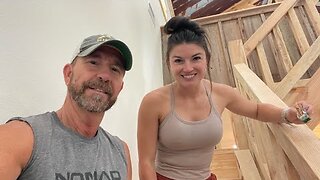Post-Vaccination Syndrome: Covid-19 Immunization. A Puke(TM) Audiopaper
Post-Vaccination Syndrome: A Descriptive Analysis of Reported Symptoms and Patient Experiences After Covid-19 Immunization.
https://rumble.com/v3t4yzj-index-of-science.-music-by-dan-vasc.html
Harlan M. Krumholz, MD, SM, and others.
Center for Outcomes Research and Evaluation, Yale New Haven Hospital, New Haven, Connecticut.
Corresponding author:
Dr. Harlan M. Krumholz
195 Church Street, Fifth Floor
New Haven, CT 06510
203-497-1246
Email: harlan.krumholz@yale.edu
medRxiv preprint doi: https://doi.org/10.1101/2023.11.09.23298266
https://www.medrxiv.org/content/10.1101/2023.11.09.23298266v1
ABSTRACT.
Introduction: A chronic post-vaccination syndrome (PVS) after covid-19 vaccination has been reported but has yet to be well characterized.
Methods: We included 241 individuals aged 18 and older who self-reported PVS after covid-19 vaccination and who joined the online Yale Listen to Immune, Symptom and Treatment Experiences Now (LISTEN) Study from May 2022 to July 2023. We summarized their demographics, health status, symptoms, treatments tried, and overall experience.
Results: The median age of participants was 46 years, interquartile range, IQR, 38 to 56, with 192 (80%) identifying as female, 209 (87%) as non-Hispanic White, and 211 (88%) from the United States. Among these participants with PVS, 127 (55%) had received the BNT162b2, Pfizer-BioNTech, vaccine, and 86 (37%) received the mRNA-1273, Moderna vaccine. The median time from the day of index vaccination to symptom onset was three days, IQR 1 day to 8 days.
The time from vaccination to symptom survey completion was 595 days (IQR: 417 to 661 days). The median Euro-QoL visual analogue scale score was 50, IQR 39 to 70. The five most common symptoms were exercise intolerance (71%), excessive fatigue (69%), numbness (63%), brain fog (63%), and neuropathy (63%). In the week before survey completion, participants reported feeling unease (93%), fearfulness (82%), and overwhelmed by worries (81%), as well as feelings of helplessness (80%), anxiety (76%), depression (76%), hopelessness (72%), and worthlessness (49%) at least once. Participants reported a median of 20, with the IQR from 13 to 30, interventions to treat their condition.
Conclusions: In this study, individuals who reported PVS after covid-19 vaccination had low health status, high symptom burden, and high psychosocial stress despite trying many treatments. There is a need for continued investigation to understand and treat this condition.
INTRODUCTION.
The vaccines against SARS-CoV-2 have saved many lives, but adverse events have been reported. The Centers for Disease Control and Prevention notes the possibility of rare complications, including anaphylaxis, thrombosis with thrombocytopenia syndrome, specifically after viral vector vaccines, Guillain-Barre Syndrome, specifically after viral vector vaccines, and myocarditis and pericarditis. These complications were not reported in the vaccine clinical trials, emphasizing the limitations of these studies in capturing rare adverse events and highlighting the critical role of post-market surveillance.
A less well-characterized adverse event is a chronic syndrome with symptoms that begin soon after vaccination. A recent preprint from the US National Institutes of Health described 23 people who reported neuropathic symptoms starting within 21 days after vaccination. The cause of this syndrome is undefined, diagnostic tests and evidence-based interventions are lacking, and its connection with vaccination remains controversial. A first step in understanding what these patients experience is a description of their symptoms, treatments, and health status. This information can lay the groundwork for enabling prevention, mitigation, and treatment. Accordingly, we sought to describe the characteristics, symptoms, health status, treatment, and experience of individuals who report post-vaccination syndrome (PVS) using data from the Yale Listen to Immune, Symptom and Treatment Experiences Now (LISTEN) study, an online observational study.
METHODS.
Study Design.
LISTEN is a cross-sectional study that collects participant-reported, participant-generated, and clinical data. Deep immune phenotyping is carried out for a subset of individuals, which involves comprehensive profiling of immune cell subtypes, their related products, and their functional states. LISTEN participants were recruited from Hugo Health Kindred, an online patient community. This platform, for which recruitment occurs mainly through social media and word of mouth, provides opportunities for information exchange, and allows members to share survey responses and health data with research studies.
The LISTEN study began recruiting participants who reported PVS in May 2022. PVS was defined by self-report in response to whether the individual thought the vaccine had injured them. We summarized these individuals' symptoms, diagnoses, treatments, and experiences.
Patient Involvement
Patients (DH, BD) were research partners in the study and participated in identifying and prioritizing the research question. Patient partners, including DH, were involved in designing the survey, assessing the burden and time required to participate in the study, recruiting participants, and interpreting results, and will be involved in disseminating the research findings.
Study Sample
The study sample includes participants aged 18 years and older who reported PVS from May 2022 through July 2023. We did not include people who concurrently reported long covid.
See Supplemental Figure 1.
Data Collection.
The Kindred platform provided a series of surveys, see Supplemental Appendix that collected demographic, infection, vaccination, clinical, and social information. The surveys were developed using an iterative process, including feedback from potential participants reporting PVS, to ensure they were relevant and understandable to those participating. The surveys were provided only in English due to funding limitations. Surveys could be completed on computers or mobile devices, and reminders were sent to encourage completion. Surveys were completed between November 2022 and July 2023, with half completed by December 2022. See Supplemental Figure 2. Data were extracted on July 7, 2023.
Variables.
The surveys included questions about the participants' demographic information, health status, and prior SARS-CoV-2 infection and vaccinations. The duration from the day of index vaccination to the day of the survey completion was a median of 595 days, Interquartile Range, IQR 417 to 661 days; range: 40 to 1058 days.
Prior medical conditions were assessed using the question, "Have you ever been told by a doctor before January 2020 that you have any of the following?" followed by a list of 30 medical diagnostic categories, eight psychiatric diagnostic categories, "other," and "none of the above." Current medical conditions were assessed similarly, with 31 medical diagnostic categories, 8 psychiatric diagnostic categories, "other," and "none of the above." The question that assessed vaccine-associated symptoms was, "Please select all the following health conditions that you have had as a result of vaccine injury," followed by a list of 96 specific symptoms, "other," and "none of the above." Self-reported health status was assessed on a 5-point scale, excellent, very good, good, fair, or poor, based on individuals' self-perceived general health.
The Euro-QoL visual analogue scale (EQ-VAS) was used to quantify the quality of life, with 100 representing the best. Symptom severity was collected by asking, "On your worst days, how bad are your symptoms, 0 being trivial illness and 100 being unbearable?"
Statistical Analysis.
We characterized participants by their demographics, age, gender, race, country of residence, marital status, pre-pandemic household income, employment status, and insurance status, vaccine type received, pre-pandemic comorbidities, PVS symptoms, symptom severity, duration of symptoms since vaccination, treatments tried, new-onset medical conditions since vaccination, and psychological and socioeconomic status. These characteristics are described using percentages for categorical variables and median and IQR for continuous variables. We then described the differences in characteristics by age, younger than 60 years versus 60 years or older, gender, and type of index vaccine. We also summarized the EQ-VAS score on people without prior substantial comorbidities. Such comorbidities did not include common allergies generally perceived as non-life threatening, dyslipidemia, and hypertension. All statistical analyses were performed in R version 4.3.1, June sixteenth, 2023.
The Yale University Institutional Review Board approved the LISTEN study. We followed STROBE reporting guidelines. Harlan Krumholz, a co-founder of Hugo Health, developed the Hugo Kindred platform, and the Yale Conflict of Interest Committee oversees his involvement.
RESULTS.
Study Sample.
The study population comprised 241 individuals with self-reported PVS, Supplemental Figure 1. Among the participants reporting PVS, 127 (55%) were those who had taken the Pfizer-BioNTech vaccine, followed by 86 (37%) who had taken the Moderna vaccine, shown in Table 1.
The participants' demographic and psychosocial characteristics are shown in Table 2. The median age was 46 years, IQR from 38 to 56; 192 (80%) identified as female; 7 (3%) reported that they were non-Hispanic Black and 209 (87%) as non-Hispanic White. There were 127 (55%) participants who received the BNT162b2, Pfizer-BioNTech vaccine, 86 (37%) the mRNA-1273, Moderna vaccine, 15 (6%) the Janssen Ad26.COV2.S Johnson and Johnson vaccine, 1 (0.4%) the NVX-CoV2373, Novavax, vaccine, and 4 (2%) the ChAdOx1 nCoV-19, AstraZeneca vaccine. Additionally, 82 (34%) participants reported being infected by the SARS-CoV-2 virus at least once.
The participants were mainly from the United States (88%), and in this group, there were 5 uninsured individuals, 176 with private commercial insurance, and 8 Medicaid beneficiaries. Before the pandemic, 194 (82%) were employed. Regarding income, 166 (69%) reported an annual income greater than or equal to 75,000 dollars. Approximately three quarters had one or more pre-pandemic comorbidities including gastrointestinal issues reported by 67 (28%), anxiety by 61 (25%), asthma by 49 (20%), depression by 49 (20%), and migraines by 46 (19%). There were 59 (25%) participants who did not have any prior substantial comorbidities. The frequencies of pre-pandemic comorbidities are shown in Supplemental Table 1.
The duration from the day of index vaccination to the day of the survey completion was a median of 595 days, IQR from 417 to 661 days; range: 40 to 1058 days.
Participants reported numerous challenges in their daily lives, Supplemental Table 2.
In the week before survey completion, 221 (93%) reported feeling unease at least once, 194 (82%) felt fearful, 192 (81%) felt overwhelmed by worries, and 180 (76%) struggled with anxiety. Furthermore, 190 (80%) felt helpless, 182 (76%) depressed, 171 (72%) hopeless, and 116 (49%) worthless at least once in the week before survey completion. Additionally, 233 (98%) felt rundown and 216 (91%) reported sleep problems. Pain interfered with the daily activities of 204 (86%) participants.
Regarding social support, 98 (41%) had two or fewer supportive individuals to rely on for help. Getting help from neighbors was described as challenging or very challenging by 86 (36%), while 24 (10%) rarely or never had assistance for tasks like shopping or visiting the doctor. Loneliness was prevalent, with 47 (20%) often feeling a lack of companionship, 55 (23%) feeling left out, and 77 (32%) feeling isolated. Furthermore, 28 (12%) often or always felt lonely.
Concerns related to living situations and food security were also prominent. Among all participants, 21 (9%) feared running out of food before they could afford to buy more, and 16 (7%) had stable housing but expressed worry about future loss. Transportation issues impeded 13 (5%) participants from carrying out essential non-medical tasks and 10 (4%) from attending medical appointments.
Timing of Symptom Onset Following Vaccination.
The median time from vaccination to the onset of any symptoms was 3 days, with an IQR of 1 to 8 days, Table 2, Supplemental Figure 3. Symptoms began after the first, second, third, and fourth (or more) vaccinations for 106 (44%), 80 (33%), 33 (14%), and 22 (9%) participants, respectively.
Health Status.
The median EQ-VAS score among participants was 50, IQR of 39 to 70, Figure 1. We evaluated the distributions of EQ-VAS scores in men. The median was 50, the IQR was 37 to 70, and women, median 51; IQR 39 to 69, age groups, less than 60 years old median: 50; IQR: 39 to 65. For Greater than or equal to 60 years old the median was 61, the IQR: 39 to 76.
And Pfizer-BioNTech, the median was 51, the IQR was 35 to 70, and Moderna the median was 50, the IQR was 40 to 62, index vaccination types, Figure 1.
The median EQ-VAS score in the participants without previous comorbidities was 52, with an IQR of 36 to 70. The median EQ-VAS score in the participants with any prior comorbidities was 50, with IQR of 39 to 66. There were 106 (44%) participants who rated their current health as fair or poor, Supplemental Table 3; Supplemental Figure 4, and their median EQ-VAS score was 40, with an IQR of 30 to 52.
Symptom Severity.
When asked to quantify symptom severity on their worst days, 0 representing a trivial illness and 100 for an unbearable condition, participants reported a median severity of 80, IQR of 69 to 89, Supplemental Figure 5; Supplemental Table 3.
On their worst days, participants who rated their current health as fair or poor reported a median symptom severity of 80 points, with the IQR from 70 to 90.
Symptom Characteristics.
The symptoms reported by the participants are shown in Figure 2, Supplemental Figure 6, and Supplemental Table 4. The median number of symptoms attributed to PVS was 22, the IQR was 13 to 35. The most common symptoms were exercise intolerance reported by 170 (71%) participants, excessive fatigue by 167 (69%), numbness by 153 (63%), brain fog by 151 (63%), neuropathy by 151 (63%), insomnia by 148 (61%), palpitations by 145 (60%), myalgia by 132 (55%), tinnitus or humming in ears by 131 (54%), headache by 128 (53%), burning sensations by 121 (50%), and dizziness by 121 (50%).
New Diagnoses since the Pandemic.
The most common new diagnoses in the study sample since the beginning of the pandemic were anxiety, 49 (36%) participants, neurological conditions, 79, 33%, gastrointestinal issues 73, 30%, and postural orthostatic tachycardia syndrome (POTS), 70, 29%.
Supplemental Table 5. There were 53 (22%) participants who reported migraine and 49 (20%) who reported depression.
Treatments.
Participants reported having taken many treatments, Figure 3, Figure 4, and Supplemental Table 6. The total number of unique treatment types was 209, which we grouped into 40 categories. The median number of individual treatments tried was 20, IQR of 13 to 30; range: 0 to 65.
The most common prescription therapies reported were oral steroids 116, 48% participants, gabapentin 61, 25%, low-dose naltrexone 48, 20%, ivermectin 44, 18%, propranolol 27, 11%, and bronchodilators 26, 11%.
More than 500 additional treatments were reported by participants, Supplemental Table 6. The most common non-pharmacological treatment included limiting exercise or exertion by 124, 51% of participants, quitting alcohol or caffeine, 105, 44%, hydration and increasing salt intake 105, 44%, and intermittent fasting 95, 39%.
DISCUSSION.
This study is the largest to describe people who report a severe, debilitating chronic condition following covid-19 vaccination. This chronic condition began soon after covid-19 vaccination and persisted in many people for a year or more. The symptoms reported are diverse and severe. Despite having tried many treatments, the median EQ-VAS score was low. Although the cause of PVS has yet to be established, this report is a step toward acknowledging the suffering it creates. It signals the need for scientific investigation to help us understand its mechanism and develop prevention, mitigation, and cure strategies.
This observational study of self-referred individuals cannot determine causality or provide estimates of the incidence and prevalence of PVS. Although there is a background rate for conditions unrelated to vaccination that can produce many symptoms reported by participants, these individuals do not have other diagnoses to explain their symptoms. Many participants did not have chronic conditions before the pandemic. Also, we excluded LISTEN participants who reported long covid.
PVS could be caused by several potential mechanisms, including a mechanism related to the vaccination or manufacturing process. It may represent a rare response to vaccines in susceptible individuals. Some investigators have concluded, based on their self-referred case series, that vaccines may cause immune system dysfunction. They focused on people with neuropathy after vaccination and could not identify other causes. In 2 of 5 participants, the cerebrospinal fluid had oligoclonal bands, and they found immune complexes in some skin biopsies. Nevertheless, the syndrome could be unrelated to the vaccination, occurring by chance during the vaccination period. However, the temporal relationship with clustering of symptom onset within the first 1 to 18 days from the index vaccine suggests a potential relationship.
The possibility that the syndrome may be related to the vaccination has implications for future vaccine development and safety surveillance.
Research in this area has the risk of being embroiled in debates about vaccinations. The net benefit of the covid-19 vaccination program is clear, and there are concerns about vaccine hesitancy. But fears of inciting vaccine hesitancy should not impede efforts to research this condition, and make progress for people who are suffering.
This study has several limitations. It is an uncontrolled observational cross-sectional study of self-referred participants who reported that they had the onset of symptoms soon after vaccination, which, in many cases, persisted for more than a year. The participants are not representative, so it is not possible to estimate the incidence or who might be most susceptible to this condition. Participating in LISTEN required people to join the community, consent to the study, and complete the surveys. This approach may have skewed our sample away from people who were too ill to participate or had substantial cognitive dysfunction. Also, the study required online access, some digital literacy, and English fluency, further limiting participation and representativeness. Since participants were strongly skewed toward those who reside in the United States and self-identify as White, efforts are needed to study a more inclusive group. Future investigations need more outreach and partnerships with diverse groups, low-income communities, communities of color, and other countries to assemble a more representative participant group.
CONCLUSION.
In conclusion, people reporting PVS after covid-19 vaccination in this study are highly symptomatic, have poor health status, and have tried many treatment strategies without success.
As PVS is associated with considerable suffering, there is an urgent need to understand its mechanism to provide prevention, diagnosis, and treatment strategies.
-
 14:43
14:43
JoBlo Horror Originals
1 day agoHarry and the Hendersons: When Bigfoot Went Hollywood
14.3K4 -
 13:49
13:49
Good Kid Productions
1 day agoXi Van Fleet on Maoism coming to Fairfax, VA (convo)
12.6K14 -
 7:07
7:07
Hannah Barron
17 hours agoDilemma in the New Kitchen!
15.5K21 -
 8:24
8:24
SaturdayMorningInspection
17 hours ago $0.01 earnedTexans Just Got A FREE AGENT STEAL
17.9K6 -
 21:17
21:17
Brewzle
18 hours agoBottling Our Barrel Picks at Cathead Distillery!
28.8K8 -
 9:43
9:43
Blue Siesta ASMR
20 hours ago $0.03 earnedASMR Hotel Check-In Roleplay | Soft Spoken
31.9K30 -
 12:33
12:33
Precision Rifle Network
15 hours agoWind Calling - Holdover vs. Dialing - Long Range Shooting
27.6K13 -
 3:28:39
3:28:39
Akademiks
10 hours agoDRAKE FIRES on Kendrick Lamar ! HOLLY ! BLOCK IS BEING SPUNN!!!!!
98.1K73 -
 1:44:46
1:44:46
Fresh and Fit
11 hours agoCRAZY Frank Castle On Disrespectful UNGRATEFUL Girl!w/ SNEAKO & SonnyFaz
175K360 -
 2:00:17
2:00:17
SNEAKO
14 hours agoSNEAKO X LAUREN CHEN
98.1K61